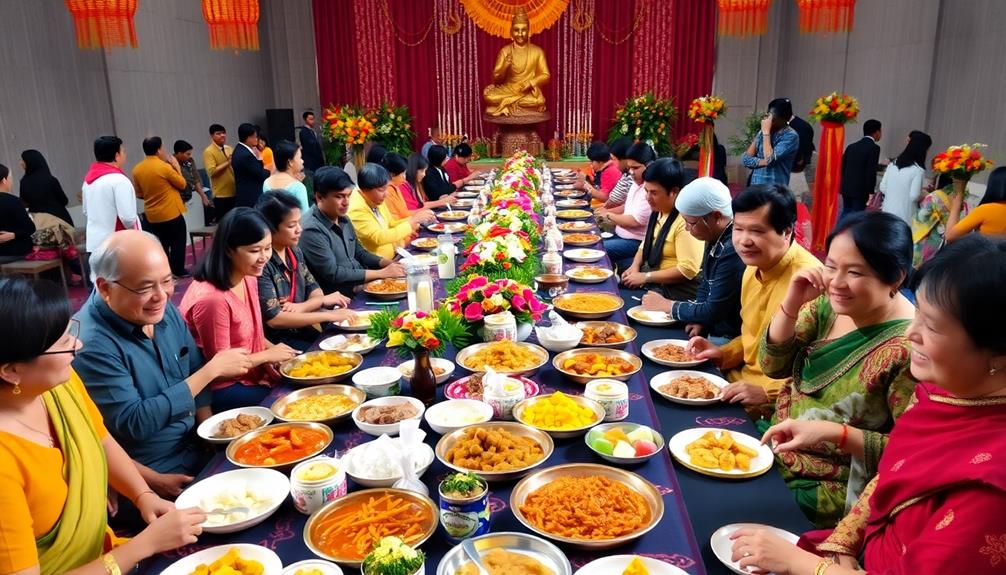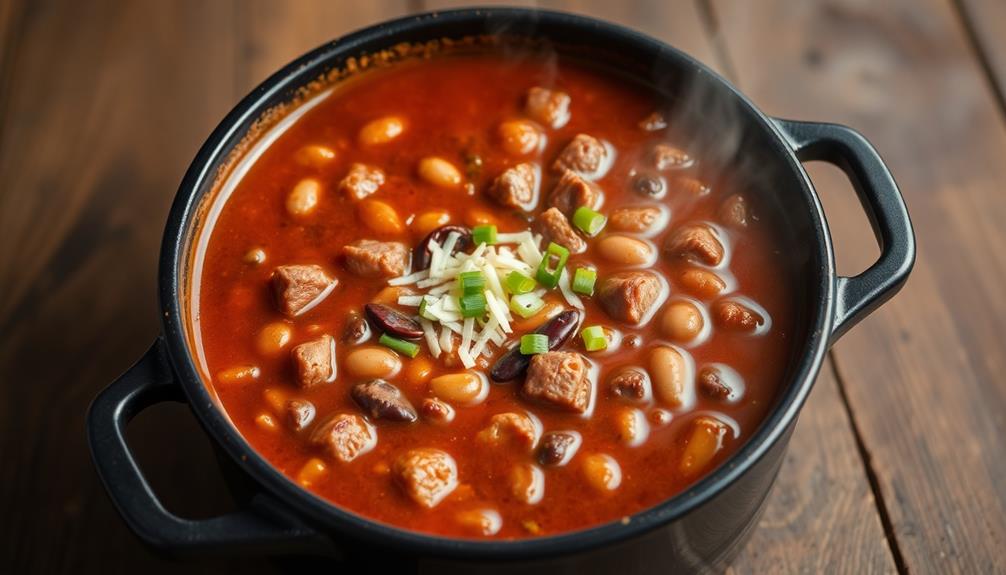Mukbang videos can greatly influence your eating habits, often increasing cravings for larger portions and unhealthy foods. The vicarious experience of watching others eat creates a comforting sense of community, but it can also distort your perception of food portions. As you engage with this content, you might find yourself more likely to indulge in binge eating or unhealthy snack choices. Regular viewing may reinforce emotional and external eating behaviors, potentially leading to long-term effects on your diet and health. For a deeper understanding of how Mukbang impacts you, there's much more to explore.
Key Takeaways
- Mukbang videos foster a sense of community, alleviating loneliness and enhancing social connections among viewers.
- Regular viewing of Mukbang content can lead to cravings for larger portion sizes and unhealthy foods.
- Exposure to Mukbang may distort perceptions of acceptable eating behaviors and normalize excessive food consumption.
- Frequent engagement with Mukbang can trigger binge-watching and binge eating, contributing to unhealthy eating habits.
- The psychological effects of Mukbang viewing may increase vulnerability to disordered eating patterns due to emotional and external eating behaviors.
Overview of Mukbang Culture

Mukbang culture, at its core, combines a unique blend of entertainment and social interaction that captivates viewers worldwide. Originating in South Korea, this phenomenon features individuals consuming large portions of food on camera while engaging with their audience. As you watch, you're drawn into the sensory experience, where amplified eating sounds heighten your connection to the act of eating.
The diverse dishes showcased, from Red-Braised Pork Belly to spicy Sichuan Cold Noodles, add to the allure of mukbang, offering viewers a glimpse into various culinary experiences.
Since its surge in popularity after 2015, mukbang has become a staple of online social networking, attracting hundreds of thousands of viewers daily. However, this trend often normalizes unhealthy eating behaviors, leading many to indulge in fast food and excessive portions. While it's entertaining, it raises concerns about potential food disorders and obesity, particularly in South Korean culture, where these habits are increasingly prevalent.
Many viewers of mukbang are solitary individuals seeking companionship, reflecting a growing trend of loneliness in modern society. Instead of sharing meals with family or friends, you might find yourself connecting with a mukbang host, creating a sense of community in an otherwise isolating experience.
Consequently, mukbang serves as both a visual feast and a commentary on contemporary eating behaviors and social dynamics.
Viewer Motivations
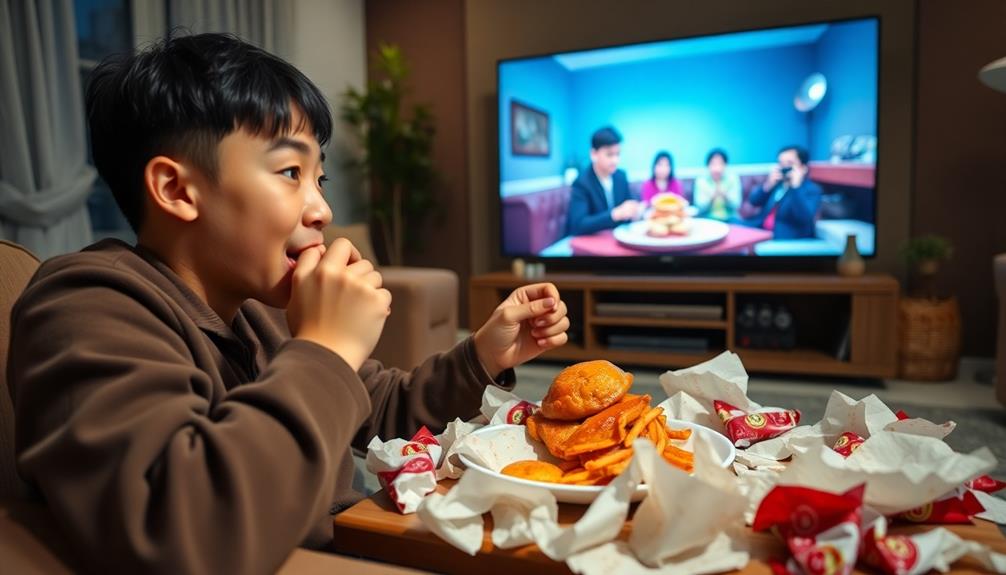
When you tune into mukbang videos, you're not just watching someone eat; you're tapping into a unique blend of social connection and entertainment. Many people find joy in sharing these vicarious food experiences, which can help alleviate feelings of loneliness.
The variety of foods showcased, such as traditional Brazilian dishes like Caldeirada, adds an element of cultural exploration that further enriches the viewing experience. This phenomenon also serves as a form of escapism, allowing you to momentarily step away from your own world while enjoying the company of others, even if it's through a screen.
Social Connection Dynamics
For many, watching Mukbang videos isn't just about food; it's about filling a void left by social isolation. When you tune into these videos, you might be seeking a social connection that's often missing from your daily life. Many viewers, especially those living alone, find solace in the shared experience of watching someone enjoy a meal.
This phenomenon creates a sense of digital commensality, where you can feel part of a community, even when you're physically alone. The communal aspect of food, as seen in various culinary traditions like the comforting dishes found in Asian Cuisine, adds to the allure of Mukbang as it evokes a sense of togetherness through shared culinary experiences.
With approximately 15% of viewers in the UK not sharing meals with family, the loneliness can be palpable. Mukbang allows you to engage in para-social interactions, forming emotional connections with the mukbangers and other viewers. These connections can enhance your sense of belonging and provide comfort.
Furthermore, the vicarious pleasures from watching mukbang—enjoying food visually without actual consumption—can satisfy cravings and influence your eating habits positively. By participating in this virtual dining experience, you're not just watching; you're joining a larger community that understands the nuances of loneliness and the need for connection.
Vicarious Food Experiences
Viewers' motivations for engaging with Mukbang videos often stem from a deep-seated need for connection and entertainment. You might find yourself drawn to these videos as a way to combat feelings of loneliness, seeking social interaction and a sense of community. Watching mukbangs can provide vicarious pleasures, allowing you to experience a shared meal without physically consuming the food.
| Motivations | Description |
|---|---|
| Social Interaction | Connect with mukbangers and fellow viewers |
| Vicarious Pleasures | Enjoy the experience of food without eating |
| Appetite Regulation | Diminish cravings through observation |
| Digital Commensality | Feel part of a communal dining experience |
| Sense of Community | Foster belonging among like-minded individuals |
This digital environment offers a unique form of escapism, helping you momentarily forget real-life issues. By engaging with mukbang content, you not only satiate your appetite for entertainment but also fulfill a desire for connection and shared experiences, creating a comforting space where you belong.
Escapism and Entertainment
Mukbang videos serve as a powerful form of escapism, drawing you in with their sensory appeal and immersive experiences. As you watch, the vibrant visuals and sounds of food consumption create a mesmerizing atmosphere, allowing you to momentarily forget about real-life issues.
This form of entertainment fulfills your desire for connection, especially if you often feel lonely. In a virtual setting, Mukbang fosters a sense of community, as viewers like you find comfort in shared experiences and interactions. The variety of dishes featured—such as Nettle and Potato Soup—adds to the allure, showcasing nutritious and comforting meals that you can appreciate vicariously.
The psychological benefits of watching Mukbang are significant; many people report feeling relaxed and less isolated. You can enjoy vicarious pleasure as you witness the enjoyment of others without needing to partake in the actual food.
The interactive nature of these videos enhances your experience, as streamers engage directly with their audience, creating para-social relationships that make you feel more connected to the content creators.
In essence, Mukbang videos transform food consumption into a communal event, offering both entertainment and emotional relief. By immersing yourself in this unique world, you not only escape your daily struggles but also find a supportive community that resonates with your experiences.
Psychological Effects on Viewers

The psychological effects of watching mukbang videos can be profound, especially for those seeking connection in a digital age. You might find that these videos serve various psychological needs, providing a sense of virtual companionship. For individuals grappling with loneliness, mukbangs can alleviate feelings of isolation, offering a form of social interaction without leaving home.
Much like enjoying a festive dish like Graveyard Taco Dip, these videos create a sense of community around food. However, your mukbang-watching frequency can also lead to unhealthy eating behaviors. As you watch mukbangers consume large quantities of food, you may experience vicarious pleasure, which can alter your eating habits—not necessarily for the better. This content might trigger binge-watching tendencies, where you consume more media than food, often responding to external cues instead of listening to your body's hunger signals.
Long-term engagement with mukbangs raises concerns about the potential development of eating disorders and poor table manners. You could find yourself adopting distorted perceptions of food consumption, influenced by the exaggerated eating styles of mukbangers.
While these videos may temporarily fulfill your psychological needs, it's essential to be aware of the possible negative impacts on your eating behaviors and overall well-being.
Eating Habits Altered by Mukbang
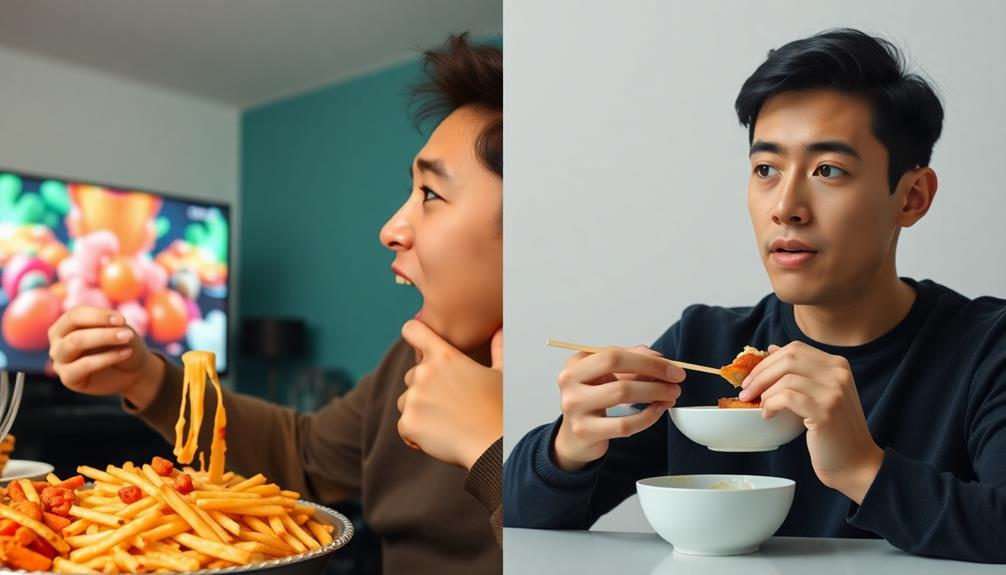
Watching Mukbang videos can really change the way you eat.
You might find yourself craving larger portions or opting for fast food instead of healthier meals, such as the Mushroom Masala or other nutritious Indian dishes. Research has shown that sleep deprivation can actually affect our taste buds, causing us to crave more high-calorie and high-fat foods. This can make it even more challenging to stick to a healthy eating plan when we’re not getting enough sleep. So, it’s important to not only focus on the types of food we’re consuming, but also consider how sleep affects our taste buds and overall eating habits. Making an effort to prioritize sleep can help us make better food choices and stay on track with our health goals.
This shift in your eating habits can lead to emotional and external eating behaviors that aren't always healthy.
Viewer Behavioral Changes
As viewers immerse themselves in Mukbang videos, they often find their eating habits shifting in unexpected ways. You might notice that, as a Mukbang viewer, your preferences lean towards unhealthy options like fast food, influenced by the excessive, calorie-dense meals showcased.
In contrast, traditional Southern dishes like squash casserole offer comforting alternatives that can be both nutritious and satisfying. Research shows that a considerable portion of female students who frequently watch Mukbang reported increased external eating behaviors, meaning you might eat based on what you see rather than actual hunger cues.
The psychological motivations for tuning into these videos, such as seeking community and social interaction, can lead to compensatory eating. You may find yourself consuming more food while watching, trying to replicate the experience.
Over time, this exposure distorts your perception of portion sizes and acceptable eating behaviors, making binge-watching and binge eating more likely.
Moreover, if you struggle with disordered eating, you might experience an exacerbation of these patterns linked to regular Mukbang consumption. This connection highlights how Mukbang can considerably alter your behavioral changes regarding eating, pushing you toward habits that mightn't align with your health goals.
Influence on Food Choices
Mukbang videos have a significant impact on your food choices, often steering you toward unhealthy options. As you binge-watch these enticing videos, you might find your eating habits shifting dramatically. The large portion sizes and calorically dense foods showcased can normalize overeating, leading to distorted perceptions of what a typical meal should look like.
Here's a quick look at how mukbang influences your food choices:
| Aspect | Impact | Result |
|---|---|---|
| Portion Sizes | Normalizes large servings | Increased caloric intake |
| Food Preferences | Promotes cravings for unhealthy foods | Preference for fast food |
| External Cues | Enhances external eating behaviors | Eating influenced by visuals |
| Binge-Watching | Encourages mindless eating | Rise in body weight |
| Eating Disorders | Potential increase in vulnerability to disordered eating | Heightened risk of eating disorders |
You may develop cravings for the high-calorie, low-nutrition options often featured, making it harder to choose healthier alternatives. By recognizing these patterns, you can better manage your food choices and counteract the negative influence of mukbang content on your eating habits.
Health Consequences of Mukbang Viewing

The allure of Mukbang videos can lead to significant health consequences for viewers, often steering them towards unhealthy eating habits. As you engage with this content, you might find yourself consuming more junk food and frozen meals, which can contribute to obesity and even eating disorders.
For instance, watching someone indulge in a lavish feast may increase cravings for rich dishes like scalloped potatoes, further enticing you to opt for comfort foods instead of healthier choices. Research indicates that a staggering 60.5% of female students watch Mukbang, with a strong correlation between Mukbang frequency and external eating behaviors.
This exposure can create unrealistic beliefs about food consumption, making binge eating more likely and distorting your perception of portion sizes. Over time, the normalization of excessive food consumption in Mukbang can exacerbate existing eating disorders and promote disordered eating patterns.
Moreover, the psychological impact doesn't stop at dietary habits; it can also affect your mental health. You may experience social isolation, as these videos can distort traditional eating behaviors and lead you to prefer solitary eating experiences.
As clinicians advocate for awareness around Mukbang's influence, it's essential for you to recognize how this content may harm your overall well-being and challenge your relationship with food.
Research Insights on Mukbang
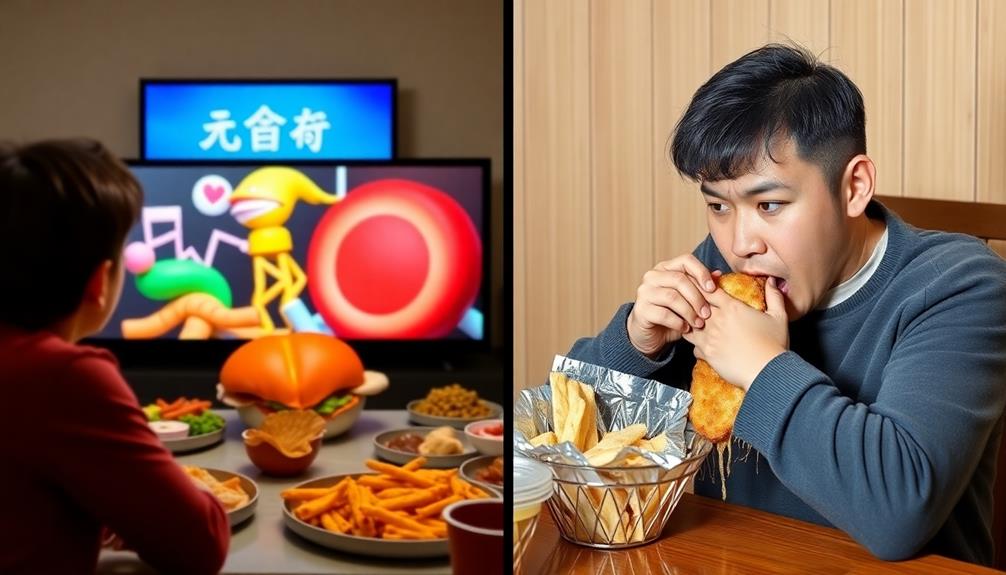
Emerging research sheds light on the complex dynamics of Mukbang, revealing a blend of both positive and negative effects on viewers. For many, Mukbang serves as a source of social connection, offering a sense of belonging while alleviating mental health issues like loneliness.
The visual appeal of food in Mukbang videos can evoke cravings for various cuisines, including traditional dishes like Chilaquiles, which may stir nostalgic feelings or cultural ties. However, this interaction can lead to compulsive behavior, where viewers find themselves increasingly drawn to the content.
Studies have shown that approximately 60% of young Chinese individuals engage with Mukbang videos, with 60.5% of female students reporting significant associations between high Mukbang frequency and intensified external eating behavior.
While Mukbang can stimulate appetite and provide vicarious pleasure, it often promotes unhealthy consumption patterns and can distort normal eating habits. Long-term exposure raises concerns about the potential development of eating disorders, as viewers may adopt unhealthy eating habits modeled by their favorite Mukbang hosts.
The psychological motivations behind viewing Mukbang are varied, but they often intertwine with viewer behavior that prioritizes entertainment over mindful eating. As research continues, it's crucial to understand these complexities to better address the effects of Mukbang on eating habits and overall mental health.
Future Research Directions
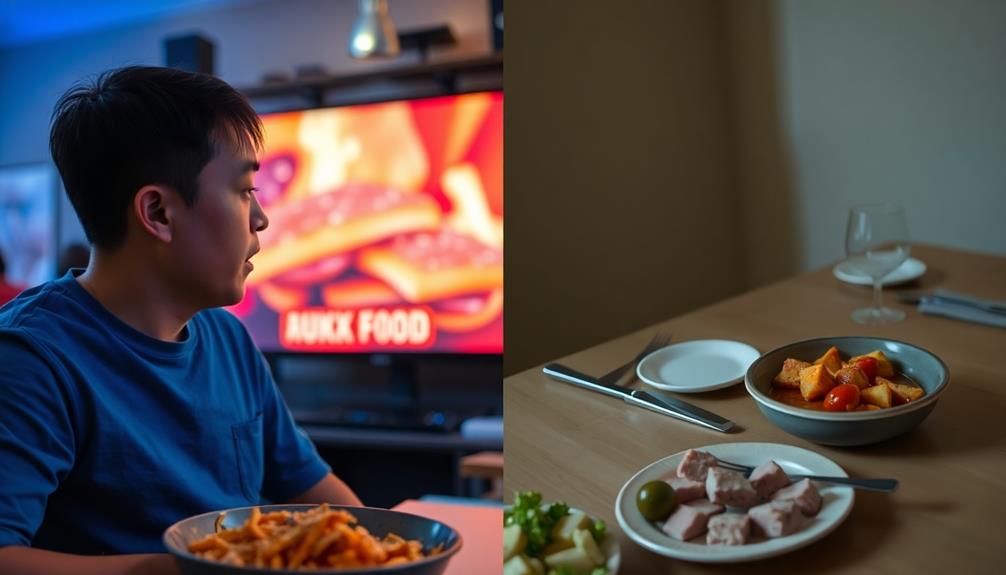
How can we better understand the lasting effects of Mukbang on its viewers? Future research should explore deeper into the psychological traits that shape viewer motivations and how these traits influence eating habits over time.
Understanding the long-term effects of mukbang consumption is vital, especially regarding dietary habits and their health implications. For instance, examining the influence of mukbang on viewers' preferences for American diner classics like loaded baked potatoes or chicken wings could provide insights into shifts in food choices.
To foster a thorough approach, consider these research directions:
- Investigate cultural variations in mukbang consumption and how demographics, like age and living situation, impact viewer motivations and outcomes.
- Develop structured measures like the Mukbang Addiction Scale to assess viewer engagement and highlight potential negative health consequences.
- Explore the therapeutic benefits of mukbang watching, focusing on its role in enhancing social connections for individuals facing loneliness or isolation.
Frequently Asked Questions
What Is the Psychology Behind Mukbangs?
The psychology behind mukbangs revolves around your need for connection and entertainment. You engage with creators and communities, finding comfort in shared experiences, while sometimes developing altered perceptions of food and social interaction in the process.
What Is the Dark Side of Mukbang?
The dark side of Mukbang lies in its potential to normalize unhealthy eating habits. You might find yourself craving large portions and fast food, leading to binge-eating tendencies and disrupting your relationship with food and eating behaviors.
What Is the Effect of Mukbang?
When you immerse yourself in Mukbang, you might feel entertained, but it can skew your perception of food. You'll notice cravings intensifying, and those large portions may seem normal, influencing your own eating habits.
Is Mukbang Eating Unhealthy?
Yes, mukbang eating can be unhealthy. You might find yourself consuming excessive portions or unhealthy foods, leading to poor eating habits and potential health issues. It's essential to be mindful of your choices when watching these videos.
Conclusion
In a world where mukbang videos serve up a feast for the eyes, it's easy to get swept away by the spectacle. You might find yourself nibbling along, turning your meals into a shared experience with virtual friends. Just remember, while it's tempting to indulge in this culinary theater, it's important to keep your plate balanced. Embracing mindful eating can help you savor your own delicious moments, ensuring your health doesn't take a backseat to the show.




